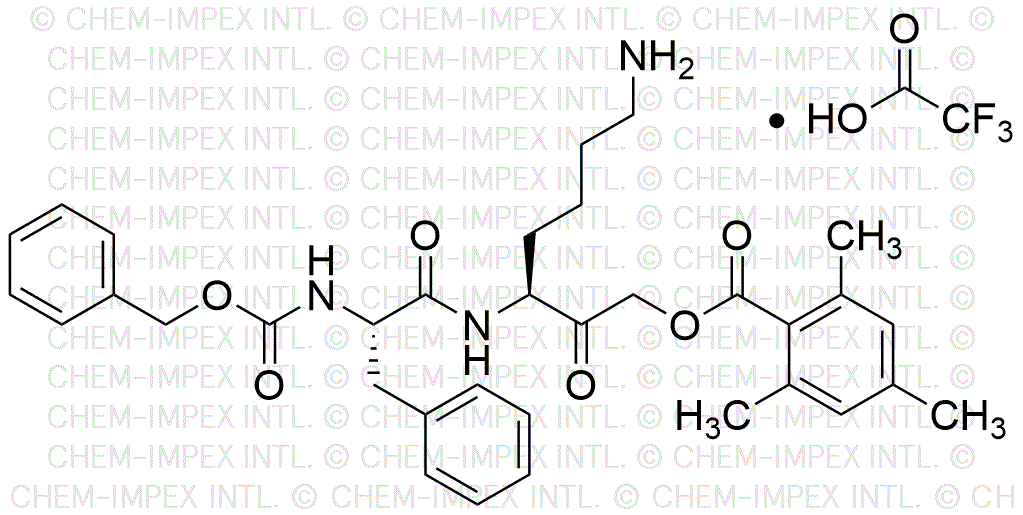Z-Phe-Lys-2,4,6-trimethylbenzoyloxy-methylketone trifluoroacetate salt is widely utilized in research focused on:
- Peptide Synthesis: This compound serves as a key reagent in the synthesis of peptides, facilitating the formation of peptide bonds. Its unique structure allows for enhanced coupling efficiency, making it valuable for researchers in biochemistry and molecular biology.
- Drug Development: It plays a crucial role in the development of pharmaceutical compounds, particularly in the design of peptide-based drugs. Its ability to modify peptide structures can lead to improved bioavailability and efficacy.
- Bioconjugation: The compound is used in bioconjugation processes, where it helps attach biomolecules to surfaces or other molecules. This application is significant in the fields of diagnostics and targeted drug delivery systems.
- Research in Cancer Therapeutics: Researchers are exploring its potential in cancer treatment, as it can be used to create targeted therapies that selectively attack cancer cells while sparing healthy tissues.
- Protein Engineering: This chemical is instrumental in protein engineering, allowing scientists to create modified proteins with desired properties for various applications, including enzyme development and synthetic biology.
General Information
Properties
Safety and Regulations
Applications
Z-Phe-Lys-2,4,6-trimethylbenzoyloxy-methylketone trifluoroacetate salt is widely utilized in research focused on:
- Peptide Synthesis: This compound serves as a key reagent in the synthesis of peptides, facilitating the formation of peptide bonds. Its unique structure allows for enhanced coupling efficiency, making it valuable for researchers in biochemistry and molecular biology.
- Drug Development: It plays a crucial role in the development of pharmaceutical compounds, particularly in the design of peptide-based drugs. Its ability to modify peptide structures can lead to improved bioavailability and efficacy.
- Bioconjugation: The compound is used in bioconjugation processes, where it helps attach biomolecules to surfaces or other molecules. This application is significant in the fields of diagnostics and targeted drug delivery systems.
- Research in Cancer Therapeutics: Researchers are exploring its potential in cancer treatment, as it can be used to create targeted therapies that selectively attack cancer cells while sparing healthy tissues.
- Protein Engineering: This chemical is instrumental in protein engineering, allowing scientists to create modified proteins with desired properties for various applications, including enzyme development and synthetic biology.
Documents
Safety Data Sheets (SDS)
The SDS provides comprehensive safety information on handling, storage, and disposal of the product.
Product Specification (PS)
The PS provides a comprehensive breakdown of the product’s properties, including chemical composition, physical state, purity, and storage requirements. It also details acceptable quality ranges and the product's intended applications.
Certificates of Analysis (COA)
Search for Certificates of Analysis (COA) by entering the products Lot Number. Lot and Batch Numbers can be found on a product’s label following the words ‘Lot’ or ‘Batch’.
Numéro de catalogue
Numéro de lot/série
Certificates Of Origin (COO)
This COO confirms the country where the product was manufactured, and also details the materials and components used in it and whether it is derived from natural, synthetic, or other specific sources. This certificate may be required for customs, trade, and regulatory compliance.
Numéro de catalogue
Numéro de lot/série
Safety Data Sheets (SDS)
The SDS provides comprehensive safety information on handling, storage, and disposal of the product.
DownloadProduct Specification (PS)
The PS provides a comprehensive breakdown of the product’s properties, including chemical composition, physical state, purity, and storage requirements. It also details acceptable quality ranges and the product's intended applications.
DownloadCertificates of Analysis (COA)
Search for Certificates of Analysis (COA) by entering the products Lot Number. Lot and Batch Numbers can be found on a product’s label following the words ‘Lot’ or ‘Batch’.
Numéro de catalogue
Numéro de lot/série
Certificates Of Origin (COO)
This COO confirms the country where the product was manufactured, and also details the materials and components used in it and whether it is derived from natural, synthetic, or other specific sources. This certificate may be required for customs, trade, and regulatory compliance.


